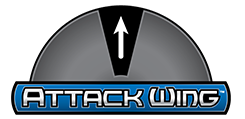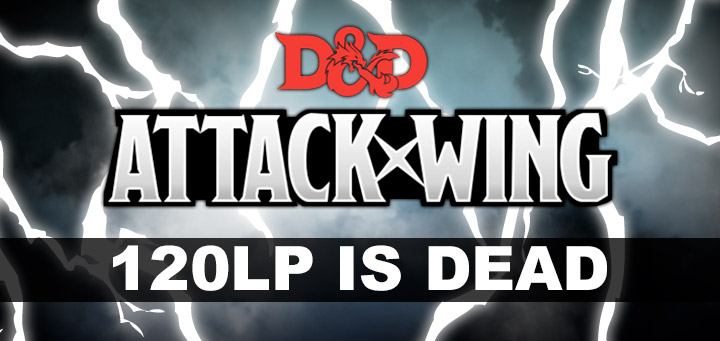120 LP is dead.
At least, that’s been the prevailing wisdom with the advent of the D&D Attack Wing blind boosters, where players were building around 90 LP and completing the army with one of five random blind units. And with blind boosters central to organized play from OP months 2 through 6, nobody’s playing 120 LP anymore. Right?
The truth, of course, is a little more complicated. Most places seem to be running D&D Attack Wing OP literally as a monthly event. And speaking as a retailer, if you’re going to be doing this only occasionally, then yeah, you’re going to want to run the format that involves selling some extra product — nothing remotely wrong with that. All the same, I’ve made a priority to support both in the shop. This isn’t a conceit: it’s worth pointing out that the D&D Attack Wing National Championships next month in Glen Burnie, Maryland are 120 LP straight up — no cracking little black boxes and hoping to get the one you want.
So reports of 120 LP’s death have been greatly exaggerated, to borrow the misquote often attributed to Samuel Clemens. It may be a secondary format, but to me it remains the “purest” form of the game. You have a moderate budget — show me the most you can do with it!
THE DEEPENING POOL
We’ve now seen four waves of units released at the time of this writing (five by time of publishing), so we’re beginning to hit the point in the game where two things are happening.
First, we’re seeing ideas spread around. Abilities that seemed perhaps unique in the beginning are starting to be shared. Vakka comes with a free Leadership. Drizzt Do’Urden will get a free Warhorse. The heroic upgrade Point Blank Shot has been offered to monstrous units as Direct Hit. The Jarl Horn ability now is offered on a card called Momentum. And so on.



The game is normalizing, and while this may seem like some of the distinctions between different upgrade classes are eroding, in reality it means that greater emphasis will be placed on what abilities you choose in conjunction with what units. This greater variety rewards builders, in that it’s something of a skill test.
Second, we’re starting to develop synergies. Units are beginning to play better with others. In the beginning, we didn’t see a lot of this. You fielded multiple “good units” and hoped to beat your opponent’s good units with solid tactical play and perhaps a dash of good luck on the dice. The more releases we get to work with, the more variety in upgrades — and not just variety in effect, but variety in choice. These all make for a deepening game.
I decided to put something synergistic together for our early March tournament at the shop, which I ended up winning. I wanted to make a build that was greater than the sum of its parts, rather than another collection of good units or ones that were more effective based on an Organized Play scenario (such as ballistae for OP 1: The Price of Knowledge or aarakocra for OP 2: The Compass of Lost Treasures).
THE BUILD
I started with Malebolge. There’s an element of design common to many games where you have an asset that under normal circumstances is rather mediocre, but when certain conditions are met grows in power. If you’re able to consistently satisfy that condition, you can have an edge over your opponent since you’re effectively getting more value from your assets than they are.



Malebolge, the iconic Gargoyle, is just this sort of card. Twenty-nine Legion Points for a 3-attack creature isn’t all that great, even with the higher health and armor. Indeed, if you make a list of all the different creatures in the game who get the most bang for their buck by comparing Primary Weapon Value (PWV) and Legion Points (LP), Malebolge clocks in at 59th. Of course, that’s assuming he’s in the air. Put him on the deck, and suddenly by the same metric he rockets up to 14th.
There are some upgrades which leap out as being auto-includes, where if you’re going to run a creature you almost always will want to have this upgrade assigned to it. The classic example is Life Drain with Lord Maximilian, making an already brutal unit annoyingly difficult to kill. I’d put Stone Jaws pretty high up there, as it not only gives you the opportunity for a second round of attack, but without any of the usual attack dies penalties or limitations assigned to doing so (see: Close Quarters, Rapid Reload, Righteous Fury, et al).
Momentum was another snap pick, because it helps shore up one of Malebolge’s greatest weaknesses in his rather feeble attack range. I also opted for Creature of Living Stone for the armor increase, and Ferocious to help maximize damage output. That put a fully-kitted Malebolge at a rather miserly 42 LP, giving me plenty of room to work with.
If Malebolge was going to be my build-around unit, I needed to have supporting players that could accomplish two objectives. First, they needed to be able to synergize with Malebolge, helping to make him be more effective than he could otherwise be. Not just on a superficial level like with Vakka’s free Leadership ability, but something that speaks to the very essence of what the unit seeks to accomplish. Malebolge wants to pound foes into the dirt — his allies would need to be able to help him do just that.
Enter Ontharr Frume and Dragonfly the Grey. As a paladin and druid respectively, each of them could be equipped with Control Weather, the single best option for ensuring your enemies are exactly where Malebolge wants them to be. Against a heavily air-based opponent, I could create a single, massive no-fly zone which would hinder their units from attaining positional superiority. Thanks to Challenge, Ontharr could also drop a single target in a pinch as a Free action.



In addition, the expansive Control Weather zone meant that Dragonfly’s Call Lightning would have a much greater opportunity to attain its full value of four dice. After all, if Dragonfly wasn’t fully reliant on creating his own storm to cast it in (as he typically would be as a blind booster unit), I could deliver a one-two punch on the same turn with Ontharr setting up the weather and Dragonfly calling the lightning. Synergy!
The second objective for the supporting cast was that they needed to be able to stand alone. There’s little use in a supporting unit that can’t hold its own in a fight. There was no guarantee Malebolge wouldn’t go down under some sustained fire or lucky die rolls, and if all of my hopes were placed in a single, 42-LP victory condition, my overall chances of winning would plunge.
Since so much of my strategy could turn on positional play, that meant giving each of them Warhorse, an amazing upgrade from the paladin blind booster. The power of Warhose isn’t necessarily in the extra range it affords you, but rather in the ability to choose — often after your opponents have already setting their forces in motion. In Ontharr’s case, Warhorse also serves a similar purpose as Momentum, since his attack range (2 with the Adamantine Lance) is also fairly limited. I also equipped both with the Helm of Leadership to double up on heroic upgrades.



That meant Bear Form for Dragonfly, giving him the option to swing for 4 dice in a pinch, double his rather feeble 2. I also opted to give him Power Attack, which increases his effectiveness if it comes to trading blows. I also gave him Prayer of Healing for his final upgrade slot. I don’t usually like healing-type effects, since I’d rather be using my turn to deal with the problem that’s damaging my units rather than simply healing up without solving the root cause of the problem. But given the ability of the Prayer of Healing to become a weapon against Lord Maximilian (common), Umberlis (infrequent), and Maurghoros (time will tell), its versatility puts it in good stead.



SYNERGY MAKES IT BETTER
So here’s a look back at the build synergies. We’ve got a primary attack unit who needs opponents to be on the ground (or swooping) for maximum efficiency, and two other support units that can ground them with Control Weather (and one with Challenge). In addition, one of the support units has a spell (Call Lightning) which maximizes in a Control Weather zone, which both supporting units can cast. That means two of these three units will be able to punch above their weight more consistently thanks to the efforts of the other two.
There’s one more element of the build that makes it so solid: the levels. If Malebolge was, say, level 11, this build would lose a great deal of its effectiveness, because the gargoyle would be more dependent on what the support units did last turn rather than this one. With Ontharr at level 10, Dragonfly at a 9, and Malebolge at an 8, each successive unit has the ability to immediately benefit from the action of the unit or units before it. Ontharr can open by dropping a Control Weather, Dragonfly can then activate Call Lightning with the bonus damage, and then Malebolge can drop his stone-fisted five-dice hammer.
Like any build, it’s not without its weaknesses. It’s predicated on the expectation that you’ll be running into a lot of flying creatures — not an unfair prediction when so many dragons and undead are tearing up the metagame. On the other hand, if all of your opponent’s units are on the ground, then Malebolge’s job just got even easier.
In addition, one unit (the gargoyle) really does provide the lion’s share of damage output, despite my best efforts to distribute threat. He’s just that strong, such as when in the tournament he one-turn crushed a fully healthy Eshaedra. You’ll have to be wary of armor penetration, but as cliché as it sounds, you may often find that the best defense truly is a strong offense.
And a strong offense, hey… that’s what Malebolge gets paid to do.

